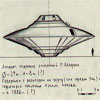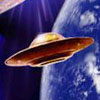A Spaceman Speaks: Overcoming Gravity ~ Part II
 Dino Kraspedon (1905–2004) was the pen name of Brazilian Aladino Felix, who claimed to be contacted by an
Dino Kraspedon (1905–2004) was the pen name of Brazilian Aladino Felix, who claimed to be contacted by an  extraterrestrial from Jupiter’s moons of Ganymede and Io. Much information of a scientific (mainly astrophysics), medical, and moral nature is given in his book.
extraterrestrial from Jupiter’s moons of Ganymede and Io. Much information of a scientific (mainly astrophysics), medical, and moral nature is given in his book.
He was born in Pedra do Baú and died in Uberaba, Minas Gerais. In 1959 he published Meu Contato Com Os Discos Voadores (My Contact with Flying Saucers). The book tells the story of his contact with a flying saucer commander at his home. The extraterrestrial visitor was given a lengthy Q&A interview by Mr. Kraspedon in which he explained advanced concepts in physics and gave insights on how to improve humanity’s social conditions on earth. Later he publicly clarified that he did not witness the male human extraterrestrial leaving or entering a spacecraft. Mr. Kraspedon correctly predicted that there would be a period of terrorism and ironically was arrested for suspicion of being a terrorist in 1968. – Wikipedia
A Spaceman Speaks: Overcoming Gravity by Dion Kraspedon
Q: I think I understand the system, it is rational enough, but the difficulty would appear to lie in making and changing this “Electric Fluid” as required.
A: You are wrong there. In Nature nothing is difficult. Things are only difficult for those who make them so. Let us go back to what I told you about an electron being a wave and not a particle. One of your physicists said, correctly, that an electron is an integration of electro-magnetic waves. But an electro-magnetic wave can be of positive or negative polarity. If we were to send electro-magnetic pulses between magnets, the waves thus produced would create an ether different from that on Earth. A variation in the distance between the plates would bring about a modification in the ether produced. That is what you wanted to know in clear and simple terms. I cannot tell you more clearly than that.
Q: Is very much electrical energy required to bring about this effect?
A: Everything is relative. On our Saucer, the voltage and current are very high indeed. On a small craft used for research, very little current would be needed.
Q: Where do you get this energy from to achieve these results?
A: There are various means of making it. It can be obtained by turning hydrogen into helium at low temperature and bombarding deuterium with heavier mesons, releasing a fabulous amount of energy; or by using ultra rays in an acid solution saturated with helium nuclei. The latter process is the most usual.
Q: How does the transformation of ultra rays into useable energy take place?
A: If you allow radioactivity to pass through a magnetic field you will get alpha, beta and gamma rays. The first are helium nuclei, the second are electrons and the third are gamma rays which are similar to ultra rays in their electro-magnetic content. These three components of radioactivity are related.
The ultra rays, or gamma rays, on passing close to helium nuclei, bring about a deformation of space and give birth to electrons until their wave energy is expended. Thus when gamma rays pass through an acid solution saturated with helium nuclei, the newly created electrons gyrate around the nuclei, but the acid prevents them from joining up with the nuclei, and they are collected on plates at the bottom of the apparatus. This provides an inexhaustible supply of energy which requires nothing more than a little acid solution and some helium nuclei.
There are, however, other means. On an interplanetary journey something might go wrong with the apparatus we use for transforming hydrogen into helium and the gamma ray collecting apparatus. If this should happen we would turn to solar energy. We would pass it through a tube of coal gas. This gas, with a suitable catalyst, unites with water, turning it into formaldehyde. This product is then oxidised giving us coal-gas and water again. In this second process solar energy is turned into useable electric current, which is quite sufficient to meet our immediate requirements, as on interplanetary voyages there is no lack of propulsive energy for the craft. The laws of inertia provide us with the necessary acceleration to reach the planet that is our objective.
Q: So that explains the whole operation of the Saucer?
A: Yes, that is how it moves. We have, however, several navigational instruments, as you were able to see. Supposing you had to explain to somebody how a jet plane moves, you would naturally say that a backward thrust is exerted which impels the craft in a forward direction. That would be true, but inside the plane there are many navigational instruments.
If I were to begin to talk to you about the equipment we use for detecting the Etheric covering of Planets, that alone would take us some three hours. The instrument we use for interplanetary communication is also complex; it is based on principles that you already know of, but have not put into practice.
The most important scientific discoveries are still to be made in the simplest things. The secret lies in concentrating on the main issue without going into abstract formula.
With a formula you can explain a phenomenon but you cannot discover it. In science we have to try to discover things, even though everything may already appear to have been discovered. To bring formula into the calculation merely complicates something that was previously simple.
How would your formula help to show that a difference of energy potential could be produced between the atmospheric pressure and a vacuum, thus producing a thrust. If you had discovered this, it would not have to be proved. The craft itself would have been sufficient demonstration. Anything else is academic pedantry.
Terrestrial science does not accept anything which cannot be proved mathematically, and is then only accessible to the few. I can assure you that many brilliant ideas have been shelved for the sole reason that their originators were not sufficiently versed in mathematics to supply the necessary proofs. This kills the spirit of research in a world where so much is yet to be discovered.
Q: We supposed, hitherto, that the saucer simply cancelled out the effect of gravity.
A: You supposed something that doesn’t exist. Gravity is no more than a wrong interpretation of a combination of phenomena.
Q: What? Doesn’t gravity exist?
A: It does not exist. What science calls gravity is a question of a difference in the density of bodies. To explain: the smoke of your cigar is heavier than the surrounding air, yet it rises as the result of warmth. That is to say the difference in density is compensated for by the temperature of the smoke. Therefore, two factors are at work which can influence this phenomenon: density and temperature.
We can see that a balloon full of hydrogen gas rises, according to the volume of the gas. The same thing happens with helium. That is to say, bodies of lesser density always tend to rise, in the same way that water and oil separate, due to density. Gravity does not prevent bodies of lesser density from rising. Whereas in air, which is of low density, heavy objects fall rapidly, in water-more dense than air-they fall more slowly. The third factor influencing gravity is the mass of atmosphere and ether surrounding a planet; this can, however, be included in the factor of density. It is wrong to attribute greater or lesser gravity to a planet without knowing the extent of its gaseous mass and the density of its atmosphere. On Saturn, for example, owing to the absence of atmosphere, gravity is considered zero. On Jupiter, which has a very rarefied atmosphere, it is quite different. A falling body has a high initial acceleration and then it collides with the low density of the planet. On Mercury, however, where the etheric covering extends more than 600,000 km., atmospheric pressure is high and gravity is tremendous.
The fourth factor influencing gravity is the vertical component of magnetism. However, the attraction it exerts on a body is, with small variations, the same as that on any other body. Thus it is that the speed of fall in a vacuum is constant. However, this attraction is not due to mass, it is caused by the magnetism with which the whole body is endowed.
Lastly, we have the energy that exerts pressure upon the Universe and penetrates our systems of galaxies, of which I spoke to you earlier. As a body cannot be subject to pressure in all directions, the Earth always shielding it from this pressure on one side, the body feels a difference in the forces acting upon it and falls to the surface of the Earth.
This tremendous universal pressure, which is the result of the vibration of God on the infinite point of the Universe, is what maintains the atmosphere of the planets.
As the atmospheric pressure has the fabulous power we use to propel our saucers, and as the tendency of gases is towards continual expansion, the whole of the gaseous envelope surrounding a planet would expand into the vacuum were it not maintained by constant pressure.
When Newton saw the apple fall, he could not guess that in that moment he witnessed the effect of the divine presence in the Universe. Thus it is that we move and have our being in God.
Gravity is, then, a combination of phenomena and never an individualized force.
Q: Why does heat affect gravity?
A: Because it reduces the magnetic force of bodies. You can prove that a magnet loses its properties on being heated. As matter is made up of stationary waves, heat has a powerful influence on them. By increasing the frequency of these waves they begin to give off light. Moreover, it is well known that heat reduces the density of a body. Accordingly, it tends to rise. This can best be seen in the case of boiling water. The warmer water tries to place itself above the cooler, producing currents. We note that heat is a factor which affects gravity, not because it is itself an agent causing the phenomena of gravity, but because it influences magnetism and density.
Q: Does this mean that our science is wrong?
A: Very wrong.
Q: Then all our physics, including relativity, fall to the ground?
A: Only the fallacious principles fall to the ground. Others will certainly remain valid. Does it seem strange to you that this should happen? Ptolemy was a genius, but his entire system collapsed like a pack of cards. The same thing happened with Aristotle. In turn, Isaac Newton came up with the physics of relativity, and its days are numbered…
Q: …Well, what about the curvature of light, observed by Eddington, Crommelin and Davidson during the eclipse of the Sun on May 29th, 1919, which formed part of Einstein’s theory?
A: The curvature of light is not due to the action of the mass of the Sun, but is caused by the magnetic center of the system situated near the Sun. Even within a solenoid you can see that a stream of electrons is deflected by a magnetic field. There is nothing new in this. If light were to be deflected when passing close to a mass, this phenomenon could be clearly observed in the vicinity of planets, let us say Mars, when it is close to Earth. Eclipses of the Moon, for example, would provide the best opportunity for such observation. Nevertheless, this curvature was only seen precisely where the magnetic center of our system is to be found. If there were no repulsion between energy and magnetism, your motors would not turn. Therefore, light is deflected by the magnetic center and curves round the Sun. If you had proper apparatus, you would see that light also curves on the side opposite the center, as though it were trying to get away from the Sun.
I wish to imply that the curvature of space is anti-scientific. Primordial space is not relative to any thing and has no form at all. It is neither a curve nor a straight line, and it has no dimensions, it is simply space, infinite in all directions. Wheresoever an observer may place himself, he will always have before him the Infinite Universe.
Q: Then no limit can be conceived to matter?
A: If in space there should be a point that could serve as a limit to creation, there God would be contained. But God is Infinite, and the Universe is a point to Him. Only a materialistic science could limit creation. If you conceive a limit, what would you then have beyond it?
Q: I should say, nothing.
A: You would have nothing but space is nothing transformed by God. Matter if it comprises anything, is the divine energy that brought life to space. To you matter may be something; but make a stream of cathode rays pass through it and it will disappear from your view. You will only see space.
All that appears is an illusion of our senses. Only one thing is real; that is Spirit, and that is exactly what earthly science does not admit.
Q: It is hard for us to learn that our most cherished concepts are completely at variance with reality.
A: Indeed, one of the bad aspects of man is his obstinacy. If I had erred for an eternity, I would welcome the day when someone would enlighten me. Believe me, I am telling you the truth. What pain can anyone feel by putting error aside and seeing the truth
Q: But it is difficult for us to abandon the science of relativity.
A: It will be difficult for science, also, to abandon the experiments of Hertz and Fresnel, who settled upon the wave theory of light. However, when science has to explain electronic theory, the wave theory is put aside; when atomic theory is in question, it turns things upside down and says that the electron is a particle, and has recourse to Planck’s theory.
Before abandoning relativity, first decide whether the wave theory or the emission theory is true. Verify the true speed of light. Determine the action and reaction of the planetary system. Never use two interpretations in one science, in order to explain the same thing.
Q: I have noted the factors which you say affect gravity, but there is a case which should be considered. If it is true that the density of bodies affects gravity, on the top of a mountain the air is more rarefied so that iron, for example, being in a more attenuated medium, should weigh more. However, the contrary is the case, the higher one goes, the less it weighs.
A: But I told you also that gravity is affected by the mass of ether surrounding the planet. If the weight of the atmosphere, at sea level, is equivalent to a column of mercury of 76 cm. for each 10 m. of altitude the column falls about 1 mm. Thus, we must consider the pressure which bodies undergo as a function of their density. The lower the atmospheric pressure, the less is the weight. If gravity were a force with its own attributes and it was that which supported bodies in space, it would be rather difficult for earthly science to explain why meteors are maintained in their orbits. Every year Earth collides with millions of meteorites, always in the same month. This means that they are located in one place. Now, if there were a law of gravitation, they would either all come towards Earth, or already have been attracted by the Sun. However, those which succeed in penetrating the mass of ether fall to Earth and the others remain in the same place. They are, then, in balance between the magnetic attraction of the center of the system and the repulsive force of the Sun. For terrestrial gravity to exist, there would have to be solar attraction, but neither of these exist.
If my reasoning were incorrect, bodies in a vacuum would never have the same speed of fall.
For the sake of argument, let us suppose that gravity exists. But if all bodies in a vacuum fall with equal velocity, it ceases to be true that matter attracts matter in direct proportion to their respective mass, at least not if this matter is in a vacuum. If this premise is demolished, it is easy to see that if a vacuum exists between the celestial bodies, solar gravitation – if it exists – should attract all bodies equally, independently of their mass. But all terrestrial astronomy is based on the mass of bodies and their distance from one another.
Therefore your conception of the cosmos is wrong. Besides, when Newton supposed a gravitational force to exist, he had to imagine the existence of an ether. He could not conceive of this force without there being a vehicle for it. And it is strange that, later, relativity denies the ether and yet approves of gravity. It admits what the discoverer of gravity himself could not admit.
This being the case, we do not cancel out gravity at all. All we do is to utilize the forces of Nature. If our craft flew on the basis of cancelling out gravity, as you suppose, we would only move in one direction. We would always fly against the Earth’s rotation, and it would be impossible to fly with it, or anywhere near the poles. Besides, we would be limited to the insignificant speed of 1,660 km. per hour.
Now, it is laughable to imagine a craft coming from another planet with such low velocity and with only one directional movement. Such a saucer would be much inferior to terrestrial aircraft and it would be a case of our coming to learn from you something about maneuverability and how to fly faster…
Excerpt from My Contact With Flying Saucers
Posted in Other Topics, Science For The New Age, UFOswith comments disabled.





